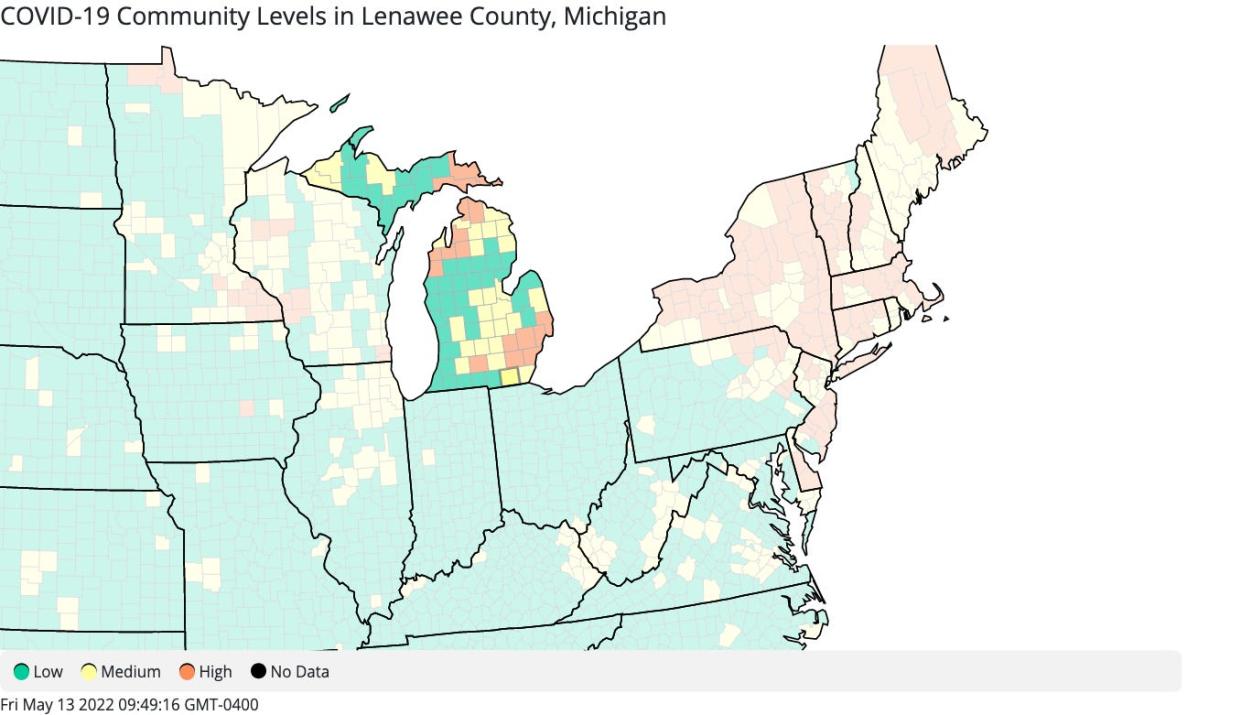Lenawee County's COVID-19 level rises to 'moderate,' CDC says

- Oops!Something went wrong.Please try again later.
ADRIAN — COVID-19 case counts have risen in Lenawee County to the level where people at risk of serious illness from the virus should consider wearing a mask, according to federal recommendations.
Meanwhile, in Washtenaw and 15 other counties in Michigan, the Centers for Disease Control and Prevention is recommending people wear masks while inside public places due to elevated COVID case counts.
The CDC updated its map Thursday evening that details community risk from COVID-19, showing all of metro Detroit now in the high-risk category as well as many in the northwestern Lower Peninsula.
Those counties are: Washtenaw, Wayne, Oakland, Macomb, Livingston, St. Clair, Chippewa, Mackinac, Emmet, Cheboygan, Antrim, Kalkaska, Grand Traverse, Benzie, Manistee and Calhoun.
In those 16 high-risk counties, the CDC recommends wearing a mask in indoor, public places, staying up to date with COVID-19 vaccines and getting tested if you're symptomatic.
Lenawee, Jackson and Monroe counties are among the 28 Michigan counties that are now in the "moderate" community COVID-19 level. The others are: Gogebic, Ontonagon, Marquette, Presque Isle, Alpena, Montmorency, Otsego, Alcona, Crawford, Charlevoix, Leelanau, Kent, Barry, Kalamazoo, Eaton, Clinton, Gratiot, Isabella, Ingham, Shiawassee, Saginaw, Midland, Bay, Genesee and Sanilac.
The recommendation in those communities is to talk to your health care provider about whether to wear a mask or take other precautions if you're at high risk for severe illness with COVID-19. In addition, the CDC suggests staying up to date with COVID-19 vaccines and getting tested if you are symptomatic.
Hillsdale County and all of Ohio except for one county at its southern tip remain in the CDC's "low" community COVID level.
The community COVID levels are based on new cases and hospitalizations over the past seven days. The CDC's update on Thursday said Lenawee County has had almost 320 new cases per 100,000 people and four hospital admissions during the past week.
The new case count is up from 26 on March 31, according to the COVID data-tracking website mistartmap.info. New cases have not been at the current level since mid-February when they were trending down from a peak of 1,856 per 100,000 on Jan. 21.
The seven-day positivity rate for COVID-19 tests in Lenawee County has risen from 2% on March 15 to 19.4% on May 10, according to mistartmap.info. The positivity rate has not been that high since Feb. 7. It reached a high of 35.2% on Jan. 19.
The state reached a seven-day average of 3,958 new daily cases on Wednesday — the highest point since February, when Michigan was coming down from the initial omicron surge.
Case rates and hospitalizations in Michigan are rising yet again as rapidly spreading omicron subvariants BA.2 and BA.2.12.1 gain prevalence.
On Wednesday, the state health department reported 823 people were hospitalized with the coronavirus — up about 90% from a month ago, when 430 people with the virus were getting hospital care.
The Michigan Department of Health and Human Services on Monday reported that ProMedica Charles and Virginia Hickman Hospital in Adrian Township had five COVID-19 patients and it was at 100% capacity with all patients. Patient counts for individual hospitals are updated weekly.
It's still nowhere near levels of hospitalization Michigan saw in January, when the state hit pandemic peaks with more than 4,600 people hospitalized with the virus.
Even though few pandemic restrictions remain in place, people can still choose to take steps to protect themselves by getting vaccinated, boosted and using some tried-and-true mitigation measures, according to Emily Martin, associate professor of epidemiology for the University of Michigan School of Public Health.
"Even though the political landscape has changed and sort of the recommendation landscape has changed, the same things work now that worked a few months ago," Martin said in a Twitter Space chat discussing the future of COVID-19.
"Masks still work, and higher-quality masks still provide a higher level of protection. Being outdoors is still better than being indoors and being in less crowded spaces is still ... better than being in crowded spaces."
Treatments like the antiviral drug Paxlovid are available now that can reduce the risk of hospitalization or death from the virus. Monoclonal antibody therapy is an option, too, for people who are vulnerable.
"And the sooner you test, the sooner you can access treatment and the sooner ... you use them, the better they work," Martin said. "There are things that we can do with a positive result to make you feel better. And so it's important to test so that you know that you're positive so then you can seek the treatment."
This article originally appeared on The Daily Telegram: Lenawee County's COVID-19 level rises, CDC says

